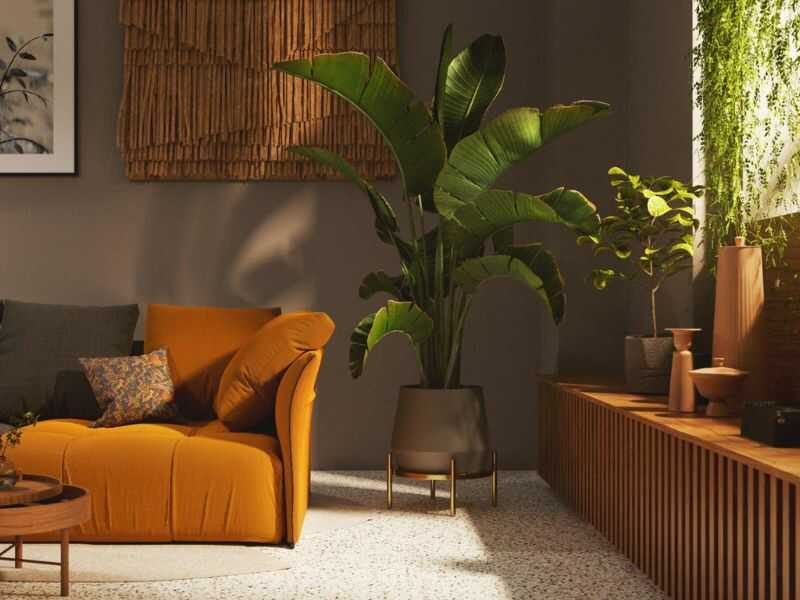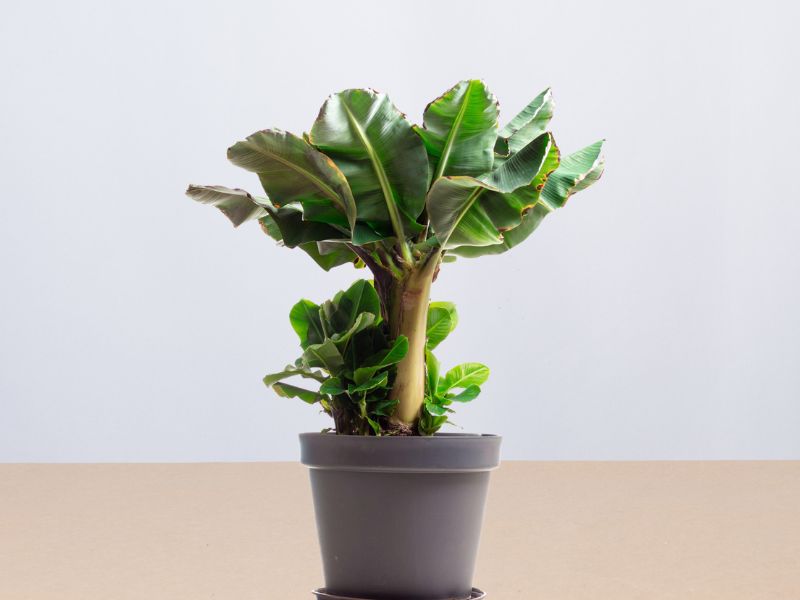
Growing a banana plant indoors is a fun and easy project that anyone can do. With just a little bit of care, you can have a healthy and productive plant. Banana plants are fast growers and can produce fruit in as little as 18 months. They do best in bright, indirect light but can also tolerate low-light conditions.
Water your banana plant when the soil surface feels dry to the touch. Allow the plant to dry out slightly between waterings to prevent root rot. Fertilize your banana plant every other month with a balanced fertilizer. Read on for more tips on how to grow and care for a banana plant indoors.
The Best Banana Plant Varieties to Grow Indoors
There are many different types of bananas, but not all of them are well suited for growing indoors. Some bananas require a lot of space and heat, which can be difficult to provide in a home environment. However, there are some varieties that are more tolerant of cool temperatures and confined spaces.When choosing a banana variety, there are a few things to consider. First, what type of climate do you live in? Bananas originating from tropical climates will need warmer temperatures and more humidity than those from cooler regions. Second, how much space do you have?
Some varieties of bananas can get quite large, so it is important to choose one that will fit in the space you have available. Here are some of the best banana varieties to grow indoors:
The Dwarf Cavendish is a popular choice for indoor growers. It is fairly compact, reaching only about 6 feet tall when fully grown. This banana does well in warm climates with high humidity levels.
The Chinese Red Banana is another good option for indoor growers. It is slightly larger than the Dwarf Cavendish, reaching 7-8 feet tall when mature. This banana does best in cooler climates and does not require as much humidity as some other varieties.
The Lady Finger Banana is a smaller variety that only grows to about 4-5 feet tall. It produces small, sweet fruits that are perfect for snacking on. This banana thrives in warm climates with high humidity levels.
Ice Cream Bananas are a hybrid variety that is well suited for growing indoors. They have a compact size and can tolerate cool temperatures. Ice cream bananas can be grown in pots or containers, and they will produce sweet, flavorful fruit even when grown indoors.
Why You Should Grow Indoor Bananas?

Banana plants are a great way to add a tropical touch to your indoor décor. They are easy to care for and can thrive in a wide range of climates. Here are some tips on how to grow and care for a banana plant indoors:
Banana plants need plenty of sunlight, so choose a spot in your home that gets plenty of natural light. If you can’t provide enough light, you can supplement with grow lights.
Banana plants like warm temperatures, so keep them away from drafts and heat sources. The ideal temperature range is between 65 and 85 degrees Fahrenheit.
Water your banana plant when the soil is dry to the touch. Allow the water to drain completely before adding more. Banana plants are susceptible to root rot, so it’s important not to overwater them.
Fertilize your banana plant every two weeks with a balanced fertilizer formulated for indoor plants. Follow the directions on the package for best results.
Banana plants need plenty of room to grow, so be sure to choose a pot that is at least 12 inches in diameter. You may need to repot your plant every year or two as it grows larger. With proper care, your banana plant will thrive indoors!
How to Grow a Banana Plant Indoors
Banana trees are one of the easiest and most rewarding plants to grow indoors. With a little bit of care and attention, you can have a banana tree that produces delicious fruits for many years to come.Here are some tips on how to grow and care for a banana plant indoors:
1. Start with a good-quality banana tree. If you can find one that is already bearing fruit, that's even better.
2. Place your banana tree in a bright spot near a window where it will get plenty of sunlight.
3. Water your banana tree regularly, making sure to keep the soil moist but not soggy.
4. Feed your banana tree with a high-quality fertilizer every few months to promote healthy growth and fruit production.
5. Prune your banana tree as needed to remove any dead or dying leaves or branches. This will also help encourage new growth.
With proper care, your indoor banana tree will provide you with an abundance of delicious fruit for many years to come!
How to Take Care of an Indoor Banana Plant

Banana plants are easy to care for and make a great addition to any indoor space. Here are some tips on how to care for your banana plant indoors:
Light: Banana plants need bright, indirect sunlight to thrive. If you cannot provide enough natural light, you can supplement with grow lights.
Water: Water your banana plant when the top inch of soil is dry. Allow the water to drain fully before putting the pot back in its place. Overwatering can lead to root rot, so be sure not to let the pot sit in water.
Fertilizer: Banana plants need regular fertilizing to produce fruits. Use a balanced fertilizer once a month during the growing season (spring and summer). You can reduce fertilizing to once every other month during the fall and winter months.
Humidity: Banana plants prefer high humidity levels, so misting your plant regularly or placing it on a pebble tray will help keep its leaves from drying out. You can also run a humidifier near your banana plant if the air in your home is too dry.
Pruning: Prune your banana plant as needed to remove dead or dying leaves and encourage new growth.
What Soil Type Is Best for Banana Plants?
There are three main types of soil: sand, clay, and loam, which are each made up of different-sized particles. The ideal type of soil for banana plants is a sandy loam; however, they will also do well in a clay loam or even a sandy clay.The main distinction between these soil types is the amount of water retention they have.Sandy soils have large particles that don't hold onto water very well, while clay soils have small particles that retain water more effectively. Loam is made up of both big and small pieces, so it holds a moderate amount of water.
A sandy loam is ideal for banana plants because it provides good drainage without being too dry. Clay soils can be amended with sand to improve drainage, but it's important to make sure the amendments are well-mixed so that the roots can access moisture evenly.
If you're not sure what type of soil you have, you can conduct a simple test by taking a handful of moistened soil and squeezing it into a ball. If it forms a ball that holds together but crumbles easily when you poke it, you have sandy loam. If the ball stays together but feels sticky, you have clay loam. And if the ball doesn't form at all or feels very gritty, you have sandy clay.
How Much Light Does a Banana Plant Need?
Banana plants need a lot of light to grow, so it is best to place them in a bright spot near a window. If you cannot provide enough natural light, you can supplement with artificial lighting. Banana plants also like warmth, so keep them away from drafts and cold windows.When to Fertilize a Banana Plant

Banana plants are heavy feeders and will benefit from a regular fertilization schedule. A general-purpose fertilizer that is high in nitrogen can be used. Fertilize every two weeks during the growing season and monthly during the dormant season.
Read : How to Grow Watermelon from Seed to Harvest
Tips for Pruning a Banana Plant
When pruning a banana plant, it is important to remove any dead or dying leaves, as well as any leaves that are infested with pests. It is also important to thin out the foliage to allow sunlight and air to reach the center of the plant. When trimming the leaves, be sure to use clean, sharp shears or knives to avoid damaging the plant.After removing any dead or damaged leaves, cut back the remaining foliage by one-third to one-half. This will encourage new growth and help keep the plant from becoming too top-heavy. When cutting back the leaves, be sure to make clean cuts at an angle just above a leaf node (the point where a leaf meets the stem).
After pruning, it is important to fertilize the banana plant. A good fertilizer for banana plants contains nitrogen, phosphorus, and potassium. Apply the fertilizer according to the manufacturer's directions.
How to Harvest Bananas From an Indoor Plant
First, identify when your bananas are ripe. Bananas ripen quickly, so you'll need to check on them regularly. Once the bananas are starting to turn yellow and develop brown spots, they're ready to harvest.Next, cut the stem of the banana plant close to the bunch of bananas using a sharp knife. Be careful not to damage the plant.
Finally, carefully remove the bunch of bananas from the plant. Hold on to the stem as you do this so that you don't damage the plant.
Once you've harvested your bananas, enjoy them fresh or use them in recipes. You can also store them in a cool, dry place for later use.
What is Banana Plant Indoor Benefits?

The biggest benefit of having a banana plant as an indoor plant is that they're extremely low maintenance; they don't require lots of water or sunlight like some other plants do. Plus, they're great at removing some common household toxins from the air, like formaldehyde!
They're also great at reducing anxiety and improving mood, so if you or someone in your family suffers from depression or anxiety, this would be a great addition to your home! Plus it's easy to care for and can provide some nice decoration to your home or office.
They're not too big, so they won't take up too much space, but they still have beautiful leaves and flowers that will make any room look nicer!
Conclusion
With a little bit of care and attention, you can easily grow a banana plant indoors. These plants are not only beautiful but also easy to care for. Follow the tips in this article, and you'll be well on your way to having a healthy and thriving banana plant in no time. - Home Garden Lot
Tags:
Garden
